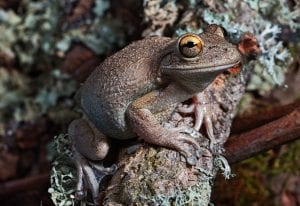A very large treefrog species that originally occurred in Cuba and the Bahamas – however it is now regarded as an invasive pest throughout many of the southern States of America, most famously in Florida, but into Southern Carolina and Louisiana and other states too. I often see individual reports of sightings much further north – it is reported this species pops up in areas it’s unlikely to survive due to the colder climate. These sporadic sightings are likely to be due to hitchhiking in commercial shipments – although the pet trade is also blamed. In the USA there is official advice to euthanise any individuals found, to stop the spread. The size of this species, along with their tendencies to eat smaller frog species accounts for the mass encouragement of culling populations. 
A large terrarium, around three to four feet long, and perhaps two to three feet tall is ideal for long term care of this species. This needs to be a moisture resistant vivarium, most keepers use glass constructed vivaria. Any real plants utilised need to be sturdy and resilient to the activities of such a large frog. Sturdy branches, and upright cork bark rolls will provide climbing decor. A medium sized water bowl, and a substrate that will help maintain plants and the air humidity required – keep the substrate moist and this will help maintain the 90-95{cb5d0a8cf0c44aef2db327d9ab0dba08dd09aed1126b509e5fa01d3aaa87fe47} humidity required. Spraying the terrarium daily will also help.
Food is easily catered for – they will eat anything that moves and they can cram in their mouths! this can be commercially available locusts, cockroaches, crickets and the like. Make sure all offered livefood is gut loaded and supplemented with a good quality vitamin and mineral dust.
To breed them in captivity is easy, just replicate the wet season. they do have a normal breeding season in the wild, but have been known to breed at any time of the year. The individuals in captivity are rarely CB.
